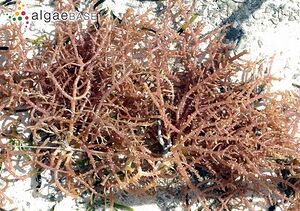Carrageenan
Origin:
The family of carrageenan is derived from red seaweeds of the Rhodophyceae class, mostly of genus Chondrus, Eucheuma, Gigartina and Iridaea. There are many processes used in its production, but the most popular are Alcohol Precipitation and KCl Precipitation. The most traditional is the alcohol precipitation process. This method can handle any type of seaweed source and is the only commercial method of manufacturing lambda carrageenan. As well, it can produce any type of carrageenan, but is very expensive due the equipment used to distill the large volumes of alcohol.
Alcohol precipitation has been slowly declining due to the processing costs. The gel press, or KCl precipitation process has taken its place due to its refined product and without the incurring extra costs of the alcohol recovery. It is essentially the identical manner in which agar is made. This process begins, with the washing, then the extraction of the carrageenan from the red seaweed. Once it is purified by filtration, potassium chloride (KCL) is used to form a large jelly-like mass that can be pressed to remove the water. The pressed cake is then dehydrated and milled according to particle size and standardized to the desired application properties.
What is it?
Carrageenan does not have a single molecular structure; rather it consists of a family of structures, a group of linear galactan polysaccharides with an ester sulfate group. It covers a wide range of colloidal behavior from a thickener to varying thermo-reversible gels ranging in textures from soft and elastic to firm and brittle. There are three main types of carrageenan; kappa, iota, and lambda. These three types are merely names given to mixtures of these types, with one type predominating.
- Kappa- for every two galactose units in the chain, there is one sulfate group. The sulfate group makes the molecule water soluble and the one anhydro bridge tends to inhibit the water solubility due to its hydrophobic properties. File:Pc prod hyd carrag-1-1-.gifkappa carrageenan
- Iota- has two sulfate groups for every two galactose units along with a anhydro bridge. This extra sulfate group makes this type more water soluble than the kappa type. File:Cim064832-1-.jpgiota carrageenan
- Lambda- this molecule has three sulfate groups for every two galactose units, but no anhydro bridge. This is the most water soluble of the three carrageenan types. File:Pc prod hyd carrag-3-1-.giflambda carragenan
What do we use it for?
Kappa is often used as a stabilizer in items like processed cheeses, ice cream, and evaporated milk. Lambda can be combined with kappa in dairy systems to create a creamy gel, as well as, kappa and iota is found in chocolate milk products or soy milks to stabilize the suspensions and improve mouth-feel. Carrageenan, in general, is often used to create body and viscosity in dessert products like puddings and flans.
Additional Information:
Kappa
- the least water soluble, but is the strongest gelling agent.
- forms firm, clear, brittle gels.
- not freeze-thaw stable.
- synergistic relationship with locust bean gum and creates elastic, cohesive gels with properties similar to gelatin.
- cold soluble, requires sufficient potassium ions to form gels.
- require heating to 60 C. to completely hydrate.
- not shear-reversible
Iota
- the most water soluble, but is the weakest gelling agent.
- forms viscous, smooth, and creamy gels.
- cold soluble, requires sufficient calcium ions to form gels.
- requires heating to 60 C. to completely hydrate.
- in milk gels, it is considered a thickener, rather than a gelling agent.
- shear-reversible
Lambda
- is shear-reversible,
- forms elastic, and cohesive textures.
- does not gel, forms sols.
- improves the freeze-thaw stability of locust bean gum
- requires heating to 60 C. to completely hydrate.
Typical Usage:
Water gel: .75% to 1%
Milk gel: .2% to .5%
Further Reading/Research: Hydrocolloids:Practical Guides for the Food Industry (Eagan Press Handbook Series), Andrew Hoefler David Arnold; Dept of Education, The French Culinary Institute
--Daniel Campagna 11:15, 3 June 2011 (EST)
